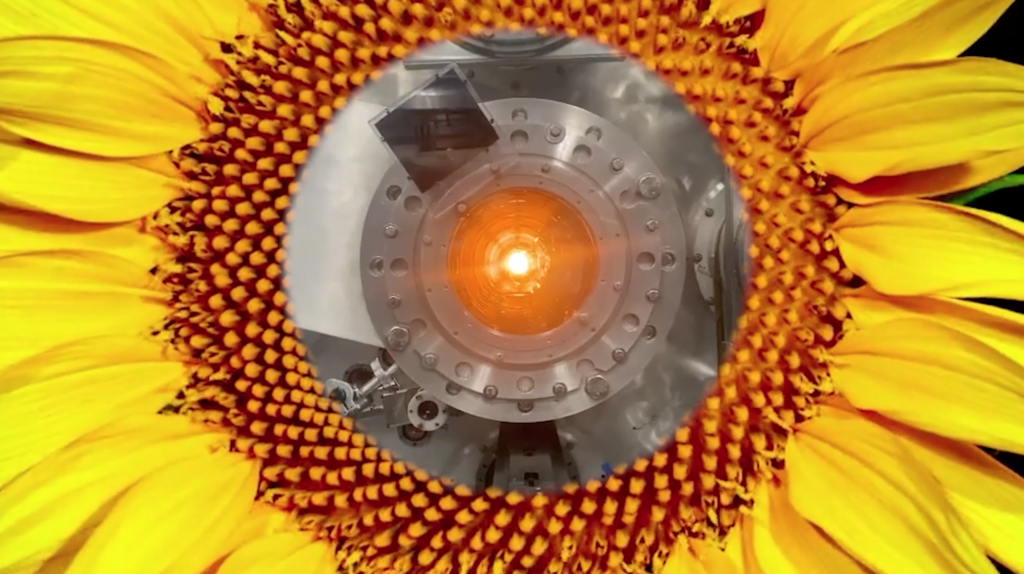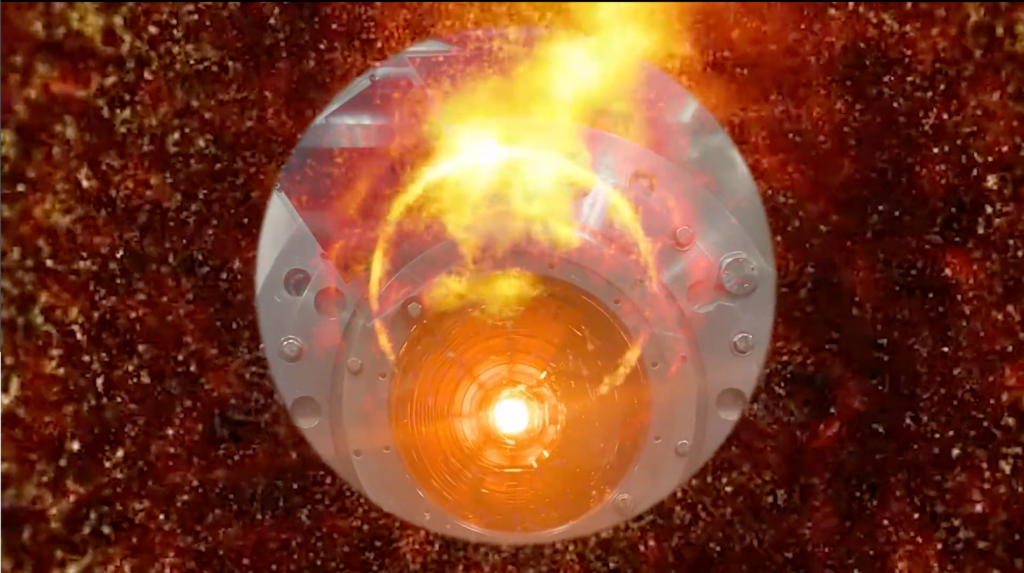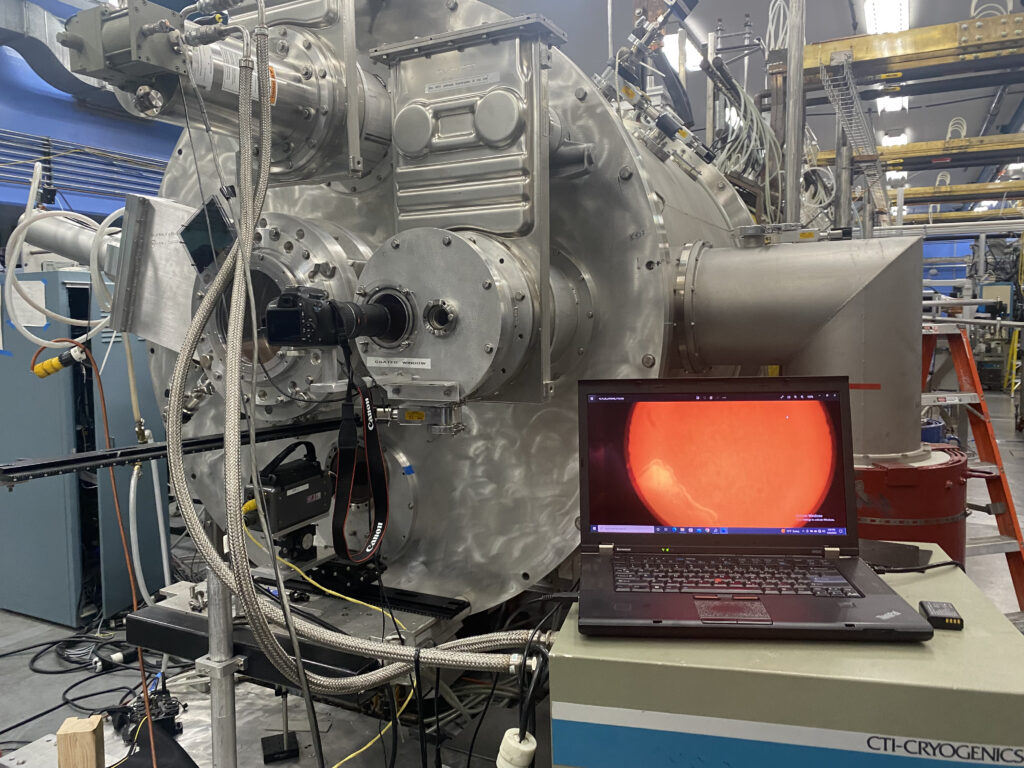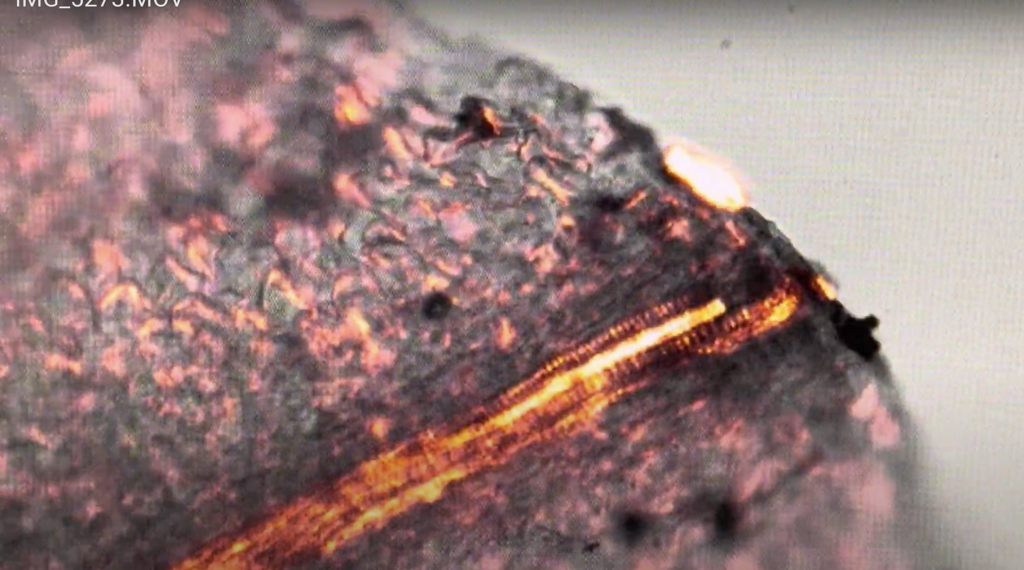[SUN] Flower Waves explores the harmonious interaction between sunflowers and Alfvén waves, demonstrating how art and science converge to reveal deeper understandings. Sunflowers, with their heliotropic movement, symbolize growth and energy, while Alfvén waves in plasma transport energy along magnetic field lines, crucial for understanding space weather and solar phenomena.
This project resulted from years of dialogue between Victoria Vesna and plasma physicist Dr. Walter Gekelman, an expert in Alfvén waves who built one of the largest basic plasma machines in the world. In addition to gathering materials from the plasma lab, Victoria worked together with biomedical engineer Dr. Haley Marks to image sunflower parts, revealing their remarkable microscopic structures resembling the sun.
Building on the “Art + Physics = Energy” explorations, [SUN] Flower Plasma delves into the ecological and geopolitical significance of sunflowers and the scientific importance of Alfvén waves. The installation features sound and images from the Large Plasma Device, solar wind data from NASA’s Parker Solar Probe, and natural recordings, offering an immersive meditation on solar energy and the cycle of creation and destruction. The sound was mixed at Harvestworks NY, adding an additional layer of depth to the experience.
LOCATION: Elements! in Art and Tech exhibition
Harvestworks Art and Technology Program Building 10a, Nolan Park Governors Island
Artist Opening Saturday August 31, 2024 from 2 – 4:30 pm. Performance by Luc Vitkova at 2:45 pm.
All events are free.
Open to the public from 11 am to 5 pm on Friday, Saturday and Sunday and by appointment. PLEASE NOTE THAT WE WILL NOT BE OPEN ON FRIDAYS IN OCTOBER.
Sunday October 20, 2024 @ 1 pm. A talk with artist Victoria Vesna and plasma physicist Dr. Walter Gekelman about their installation [SUN] Flower Waves that explores the harmonious interaction between sunflowers and Alfvén waves, demonstrating how art and science converge to reveal deeper understandings. FREE.

Consider the sunflower, with its radiant bloom following the sun, and Alfven waves, which are magnetohydrodynamic waves in plasma traveling along magnetic field lines. Both the sunflower and Alfven waves exemplify a harmonious interaction between natural elements and forces, illustrating how art and science can intertwine to reveal deeper understandings.
The sunflower’s heliotropic movement, where it follows the path of the sun across the sky, is a natural manifestation of phototropism, a biological response to light. This elegant dance with the sun not only optimizes the plant’s ability to photosynthesize but also symbolizes growth, energy, and the intricate patterns found in nature.
Similarly, Alfven waves propagate through the plasma of the sun’s corona and the interstellar medium, transporting energy along magnetic field lines. These waves play a crucial role in space weather phenomena, influencing solar wind and magnetic fields that impact our planet. The study of Alfven waves provides insights into the dynamics of the sun and other astrophysical bodies, highlighting the delicate balance of forces at play in the universe.
By drawing parallels between the sunflower’s interaction with sunlight and the behavior of Alfven waves in cosmic plasma, we can appreciate the interconnectedness of all things, from the smallest biological systems to the vast expanse of space. This connection underscores the importance of interdisciplinary approaches, where the principles of art and science converge to deepen our understanding of the world and inspire solutions to global challenges.

This concept is at the heart of the SUNFlower Waves project. Victoria Vesna joined forces with one of the top experts in Alfven waves, experimental plasma physicist Dr. Walter Gekelman, who is recognized for his pioneering work on Alfvén waves and ion acoustic instabilities and turbulence in a magnetic field and flux ropes. He constructed the original Large Plasma Device, a 22-meter-long machine with a 60 cm diameter, 18-meter-long fully ionized magnetized plasma. The magnetic field can be as high as 2.0 kG and is the largest, most versatile basic plasma device in the world.
Building upon their joint teaching experience from the previous year’s “Art + Physics = Energy” class, which included a visit to the National Ignition Facility at Lawrence Livermore Laboratory, they developed a conceptual framework for this complex project. During this time, they planted sunflowers and explored their complexity in various cultures, recognizing their direct connection to the sun and the harmonious interplay of ecological factors such as nutrients, pollination by insects, and the underlying genetic blueprint. Furthermore, their discussion extends to the geopolitical dimensions of sunflower oil production, predominantly centered in Russia and Ukraine, and its global transportation to countries like China.
The connection between Alfven waves and sunflowers goes deeper than a mere metaphor. Alfven waves, named after the Nobel laureate Hannes Alfven, are fundamental to understanding the behavior of plasmas in the solar system and beyond. These waves transfer energy and momentum through the plasma, influencing phenomena such as solar flares and the auroras on Earth. This energy transfer and interaction within the plasma can be seen as a cosmic dance similar to how sunflowers interact with solar energy to thrive and grow.

Videos and imaging come directly from the Large Plasma Device lab, which was used for pioneering experiments on the propagation of Alfven waves, along with some sourced from NASA’s Parker Solar Probe. Microscopic imaging was enabled by biomedical engineer Haley Marks, who specializes in advanced light microscopy. She trained Victoria to use this technology to image sunflower petals, pollen, flower, and stalk. Remarkably, these images revealed structures resembling the sun, reinforcing the profound link between the sunflower and solar phenomena. Just as the sunflowers exhibit patterns and behaviors guided by sunlight, the Alfven waves demonstrate the underlying principles of energy and movement in the universe. This parallel provides a compelling visual and scientific narrative, bridging the gap between the microscopic beauty of nature and the vast, dynamic processes of astrophysics.
The auditory journey involves a rich tapestry of sounds, including ambient noise from plasma physics fusion labs, data sonification of movement within the plasma machine, solar wind recordings from space agencies like NASA and ESA, three-dimensional representations of bee hives, polyphonic chants, bird songs, and a diverse array of animal calls. This immersive experience serves as a meditation on the energy of the sun and humanity’s endeavors to achieve fusion, while also presenting a cycle of creation and destruction.

• BIOS
VICTORIA VESNA, Ph.D., is an artist and professor in the UCLA Department of Design Media Arts and the founder/director of the Art|Sci Center at the School of the Arts and California NanoSystems Institute (CNSI). Trained as a painter at the University of Belgrade, her work now resides at the intersection of disciplines and technologies, focusing on experimental creative research. Her installations explore how communication technologies affect collective behavior and perceptions of identity in relation to scientific innovation (Ph.D., CAiiA-STAR, University of Wales, 2000).
Victoria’s work involves long-term collaborations with composers, nanoscientists, neuroscientists, and evolutionary biologists, enriching her students’ learning experience. She has exhibited in numerous solo and group shows and delivered over 100 invited talks in the past decade. She serves as the North American editor of the AI & Society journal (Springer Verlag, UK). Her publications include “Database Aesthetics: Art in the Age of Information Overflow” (Minnesota Press, 2007) and “Context Providers: Conditions of Meaning in Media Arts” (co-edited with Christiane Paul and Margot Lovejoy, Intellect Ltd, 2011). Currently, she is co-curating the exhibition “Atmosphere of Sound: Sonic Arts in Times of Climate Disruption” and working on a new book, “Vibrations Matter: Art & Science of Listening” (Routledge Press, forthcoming fall 2024).
WALTER GEKELMAN currently leads the Large Plasma Device (LaPD) laboratory at the University of California, Los Angeles. The original machine was funded by the Office of Naval Research and a major upgrade funded by the National Science Foundation. The LaPD is now a national user facility funded primarily by the Department of Energy office of Fusion Science. He and his students have worked on a number of problems related to space and solar physics. These include a variety of waves (Alfven, whistler, lower hybrid, Langmuir, ion acoustic) to name a few. Experiments on magnetic reconnection, processes in which magnetic energy is converted to other forms occur when magnetic ropes collide or in intense laser plasma interactions. Additional studies involve trapped particles in the earth’s radiation belts caused by ejection of plasma from the sun. In addition to the work on basic plasma physics he is engaged in a low temperature plasma physics program with industrial support from LAM research corporation, one the world’s biggest manufacturers of etch and deposition tools used by the semiconductor industry. For years now Prof. Gekelman has engaged in projects on the intersection of science and art with Prof. Victoria Vesna in the media arts department.
HALEY MARKS, Ph.D. is a biomedical engineer with interests in nano-biosensor research, translational medicine, and optics education. She has expertise in developing novel reporter dyes, nanoparticles, and has extensive experience working with spectroscopy/microscopy instrumentation, 3D printing, and developing microfluidic and lateral flow assay platforms. Since joining CNSI in 2022, Haley has served as a technical expert, providing advanced light microscopy training and services to ALMS users. She works developing and optimizing ALMS’s existing super-resolution and high-speed optical methods, developing strategies and imaging tools for in vivo imaging, and optimizing and disseminating computational imaging techniques. Haley was a recipient of the Whitaker International Fellowship and of the SPIE Franz Hillenkamp Fellowship.
• ADDITIONAL MATERIAL:
https://soundofatmosphere.com/
http://sunflowerplasma.com (note – this is in progress – will be up in July)
• WEBSITE AND SOCIAL MEDIA LINKS:
http://victoriavesna.com;
https://www.instagram.com/victoriavesna/
https://www.facebook.com/victoriavesna
About the Elements! in Art and Tech exhibition. Programmed for the annual Harvestworks Art and Technology Program Building on Governors Island, the artworks in this group show are inspired by elements of light, water, earth, flower plasma and their influence on humans. Selected by the Harvestworks arts committee and the Executive Director Carol Parkinson, the works use creative technology such as audio/video spatialization, gesture, body tracking and vegetal power.






